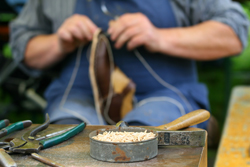Europe's shoe industry – rough and ready
Problems associated with the conventional method for attaching soles to the upper material of shoes can cost manufacturers up to 1% of their turnover. The current process can also pose a major health and safety risk to workers. Therefore, a new technique for attaching soles was developed to cut manufacturing costs and improve conditions in the work environment. The 'Improving roughing with integrated sensor technology' (IRIST) project was funded by the EC Growth Programme. The project developed new processes for treating leather and synthetic materials, providing an improved surface for attaching soles for both adhesively bonded and direct injection moulded shoes. It is hoped that the work of the IRIST project will help European SMEs to save EUR 125 million a year. Researchers from the University of Newcastle designed an automated system for 'roughing' shoe uppers by blasting them with abrasive grit propelled in a jet of air. The British team used a simple mask to ensure a clearly defined edge to the roughed area, although this had the potential of weakening the leather. Additional experiments proved that the mask needed to be in contact with the leather in order to achieve the best results. Small amounts of dust and grit on the shoe uppers were capable of producing damage and affecting the appearance of the leather. The project researchers analysed a number of different masks for protecting the uppers from excessive roughing. A design was selected based on a rotating satellite disc that followed the contour of the shoe. Test results were very encouraging, showing a clearly defined difference between the processed part of the shoe upper and the part with no visible sign of wear. Improving the process for surface treatment of leather and synthetic material will help the shoe industry to produce a better product, reduce wastage and provide healthier working conditions. Customers will be able to benefit from cheaper and better quality footwear while providing a boost to European manufacturers.







